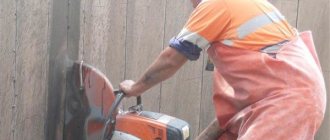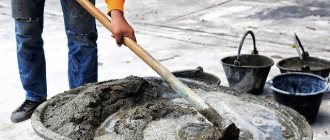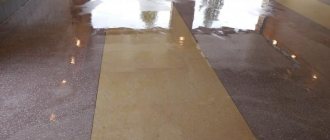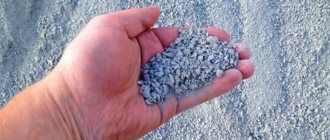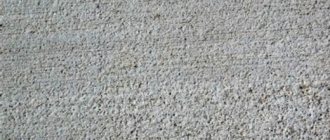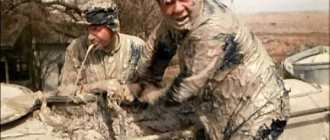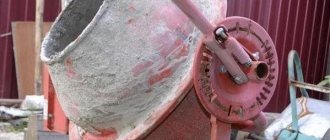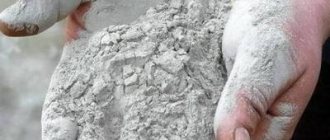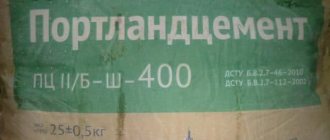When constructing a foundation, it is necessary to strictly adhere to technology, otherwise it will quickly begin to collapse, which will entail deforming processes in the walls and ceilings.
When constructing a strip foundation, professional builders pour a sand or crushed stone cushion onto the bottom of the trench.
Is it necessary?
Some private developers, for whom cost-effective construction is important, believe that it is not necessary to lay a cushion under the foundation. They believe that if the house is built on dense soil, they can do without it.
In fact, it is a mandatory element of the strip foundation, because:
- Ensures uniform distribution of the impact of construction on the soil.
- Prevents foundation subsidence.
- Acts as an additional barrier between the base of the building and groundwater.
Is a sand cushion needed for, for example, a strip foundation on clay? A sand or crushed stone cushion is needed during the construction of any object, regardless of:
- soil quality,
- dimensions of the building,
- foundation depths,
- other factors.
It provides stability and strength to the base. At the same time, it protects it from moisture and compensates for soil movements, keeping the base of the building motionless.
Kinds
Usually the pillow is made of sand. When leveling the bottom of the trench, sand is also used, but this is not a cushion, but simply an auxiliary layer of 2-3 centimeters. In addition to sand, crushed stone or concrete mortar is used for embankment.
Sand pillows are the most economical . They are used in the budget construction of small buildings. You need to purchase coarse sand, otherwise the base will not be hard enough.
It is necessary to pour sand in layers, carefully compacting each layer 10 cm using water. Sand mounds are made from 20 to 40 cm in height. The surface must be perfectly leveled.
Under a house on soft soil, a cushion of sand alone may not be effective. Crushed stone is added to it, which makes the base resistant to shrinkage .
The mixed base is stronger, more durable, and better protects against moisture. When building private cottages, it is recommended to use such combined pillows.
Crushed stone and sand can be mixed . But it is better to pour the materials in layers - first a layer of sand, then crushed stone. The layers should be up to 20 cm. The filled sand must be carefully compacted and leveled. After pouring crushed stone, you need to walk over it and also level it, check whether voids have formed.
The pillow can only consist of crushed stone. A gravel or granite variety is used. Usually gravel is purchased because it is cheaper and more convenient to use. Crushed stone is more stable than sand. It absorbs less water and has a longer service life. It is used in the construction of two and three-story cottages.
There is also a concrete option . In fact, the concrete subbase is an additional element of the foundation. It is installed on top of a fairly high sand cushion (up to 50 cm). Concrete is a thin monolithic reinforced layer of concrete on which the main part of the foundation is built - formwork, reinforcement cage, pouring concrete.
Another option is to lay ready-made concrete slabs instead of a poured layer of concrete. The concrete base is quite expensive. Rarely used in low-rise construction. But in some cases it becomes the only way to arrange the foundation.
For example, using a concrete pad, you can build a large massive house on a site with problematic soil.
Mixing Features
If you decide to prepare a solution for floor screed, you can find out the proportions by reading this article
However, it is also important to know how the ingredients are mixed. Please note that dry and liquid ingredients should be mixed in different containers
Initially, it is necessary to combine all dry components, including fiber, cement and sand. Use cement mortar M 400, mixing it with sand, using a ratio of 1 to 3. Thus, 16.7 kg of cement will be needed for 50 kilograms of sand. Dry elements must be mixed for 5 minutes. Next, you should move to another container in which plasticizer and water are added. Approximately 190 grams of plasticizer should be added to a 50 kg bag of cement. Water should be added in an amount of 1/3 of the mass of cement.
For a third of a bag of cement you will need to add 5.6 liters of water. When mixing the floor screed solution (the proportion of each brand is indicated above), it is necessary to take into account that the plasticizer will require 0.6 liters. If you decide to prepare a floor screed solution yourself, the proportions for it are presented in this article. After completing all the steps described above, you can begin to mix the liquid ingredients; to do this, you need to gradually add the dry mixture to the container with the liquid, stirring it well. If you pour liquid into a dry mixture, lumps will form, and it will be very difficult to get rid of them afterwards.
Materials
There are special requirements for materials for constructing an embankment under the foundation. They should be:
- durable,
- moisture resistant,
- frost-resistant,
- inexpensive.
Sand
The sand must be coarse . The larger the grains, the higher the quality of the base. Coarse sand is easier to compact and level, and the cushion made of it has high load resistance.
There should be no impurities in the sand. They are dangerous because they can radically change the properties of the pillow. Clay impurities are especially harmful.
Clay absorbs moisture . It makes the pillow too mobile and weak. The clayey foundation will not be able to perform its functions; the foundation will quickly “float” and fail.
Gravel
Typically, crushed stone with a fraction of 40 mm is used for backfilling. It compacts well, is resistant to low temperatures, and its strength is M1200. This material is absolutely safe and can be used in the construction of residential buildings. To save money, it is allowed to use secondary crushed stone obtained by crushing waste concrete.
Experts recommend pouring granite . This is not the cheapest crushed stone option, but it has excellent characteristics. A pillow made from it will become a durable, reliable support for your home.
Properties of components and their influence on composition selection
Concrete components
The number of components in concrete depends not only on its brand. The characteristics of the raw materials also have a huge impact, which can vary the ratio of cement, sand and crushed stone in concrete when producing a mixture of the same class.
Cement
Portland cement is the main binder. It is from its quantity that they start when determining the ratio.
And the calculation of cement for concrete depends on the following characteristics:
- Brand. The higher the grade of Portland cement, the greater its strength. Accordingly, the higher the grade, the less the amount of cement in a cube of concrete. The thought immediately arises: “I’ll buy the best cement, for example, M500D0, add its minimum amount, thereby saving on the most expensive component of concrete.” It’s hard to call such an act frugality, because the price for such a binder is decent.
Cement packed in 500 kg
Okay, let's go the other way, buy M400D20, which is cheaper, but this is also a dubious saving, since due to the lower grade strength, you need to add much more of it to the concrete, and the cost of the cube will increase accordingly. However, such a replacement is justified in many cases.
For example, when producing concrete of a grade not higher than M400, and only if the strength of the sample at 28 days of age meets the state standard requirements.
- Steaming activity is the most important characteristic of cement. It shows how quickly the concrete will gain formwork strength. It can be different even for cement from the same supplier for different batches. This parameter is determined only in laboratory conditions. There are 3 groups of steaming activity. The best is the first, and accordingly, the worst is the third.
Beams for determining activity during cement steaming
Which one is needed in a particular case depends on the specifics of production and the structure being manufactured. This does not particularly affect the ratio of cement and sand in concrete; they usually extend the heat and humidity regime or the standing time, if the activity is absolutely useless. But, if the budget allows and faster hardening of concrete is required, then in this case a larger volume is taken.
- The date of manufacture of cement is as important as the date of release of the food product. The fresher the binder, the better quality it is. Therefore, manufacturers do not purchase it in advance at a lower cost in the winter. After the “fulfillment” of the month of cement, a countdown begins. Its brand strength is slowly decreasing. This process occurs much faster if the cement is stored in open bags and in a moist environment. Therefore, “old” binder is added to concrete in excess of the norm.
Attention! If you come across lumpy cement, don’t feel sorry for it and throw it away, as nothing good can be made from it.
Water
Dosing water into solution
The water-cement ratio is a sore subject for any concrete worker.
As many people know, adding an excessive amount of water to the working solution leads to a decrease in grade strength.
- It must be dosed in the ratio of exactly the amount of cement used for 1 cubic meter of concrete, which is approximately 30% of its mass. That is why rigid semi-dry mixtures are distinguished by good brand strength, frost resistance and durability.
Semi-dry concrete with fiber
- But with this W/C solution, completely non-plastic solutions are obtained. Therefore, it is not always appropriate to make non-flowing mixtures.
- The concrete hardness grade is usually indicated in projects, but if it is not available, especially on construction sites, water is dosed “by eye,” which is not good.
- The table below clearly demonstrates the dependence of the strength of concrete on the amount of water in it.
Table of w/c ratio and strength
- Therefore, before putting the nominal mixture recipe into mass production, test batches are made during which the selection of the composition is adjusted.
- When testing samples in laboratory conditions, the most suitable concrete formulation for workability and strength is identified. This is why plasticizers are so loved by builders.
Plastic concrete: the ratio of cement and sand is normal
Note: Using plasticizers, you can reduce the w/c, and even the amount of cement, and still get “good” concrete. But, again, a dilemma arises - how profitable is this, because the price of plasticizers, oh, how “bites”! Therefore, “miracle masters” appear who advise adding cheap detergents to concrete, or “not bothering” at all and preparing solutions the old fashioned way.
What will win: “thrift” or “voice of reason”?
- I would also like to touch a little on the topic of water requirements for cement. This characteristic shows the water-cement ratio at which the normalized plasticity of Gost cement mortar is obtained.
- It does not have a huge impact on the proportions of cement sand and crushed stone for concrete. But it happens that some cements require a little more water, some a little less than the established value.
Cement beam test
- No additional tests are carried out to determine this property. This is clarified in the process of preparing cement paste for beams, which, after steaming, will be samples for testing the strength and activity of the binder.
Note! Knowing that the cement used in production has a high water requirement, the selection of the composition is not changed in advance, but they keep in mind that if the process of laying the mixture becomes more complicated, the water-cement ratio will need to be adjusted. In this case, samples of the batches must be taken for detailed laboratory testing.
Fillers
Now let’s plunge headlong into the abyss of information on large and small aggregates. When designing a certain brand of mixture, they try to minimize the consumption of cement for concrete, but at the same time, so that it corresponds to a certain brand strength and ductility.
To achieve this, large and fine aggregates are used. It not only reduces the amount of cement paste, but also adds strength characteristics (especially for crushed stone).
Cuboid crushed stone, fraction 20-40 mm
If we talk about heavy concrete, then when selecting the composition, the amount of sand is taken with some excess compared to the volume of crushed stone. In the case when a recipe for concrete made from sand and cement is calculated, then, provided that coarse aggregate is not used, the voids of the solution increases and is approximately 27%, which leads to a greater use of cement paste. And this is almost 2.5 times more than when dosing crushed stone.
Interesting fact! On construction sites, when monolithing large areas, for example, when pouring a slab foundation, “raisins” are used - cobblestones in order to spend as little expensive concrete as possible.
The photo shows different fractions of crushed stone
The size of the aggregates itself also plays an important role. Its fineness modulus is taken into account when designing concrete.
For example, for foundations, as a rule, crushed stone with a fraction of 20-40 mm is used, and for the production of floor slabs, aggregate with a particle size of 5-10 mm is used. At the same time, the ratio of crushed stone in concrete varies depending on the design grade. But, on average, approximately 5 parts of crushed stone are taken to 1 part of cement.
Technology of work execution
Regardless of the material chosen, the pillow should be poured strictly according to the technology:
Sand
It is carried out according to this scheme:
- The bottom of the trench dug under the strip foundation should be leveled and compacted.
- If the soil is dusty or clayey, you need to remove a small layer and replace it with a stronger bedding, then level and compact it.
- A sheet of waterproofing material is laid at the bottom, which will protect the materials from ground moisture and prevent sand from mixing with the soil.
- For greater strength of the base, the bottom layer should be laid out with rubble (possibly in 2 layers).
- Sand is poured on top (as it is added, it must be moistened with water and compacted).
- Level the surface of the sand cushion using a platform vibrator or roller.
- The formwork for the foundation strip is installed on top of the cushion.
The height of the sand embankment depends on the characteristics of the soil and the features of the future building. In most cases, making it larger than 30 cm is impractical - stability will be lost.
The easiest way is to calculate the width of the tape that will be poured after installing the pillow. The height of the pillow should be three times the width of the tape. The width of the base is approximately 30 cm greater than the width of the tape.
Shchebnevaya
Sand is usually poured under the crushed stone . The process begins as when laying a simple sand cushion. But with a lower height of the sand embankment (10-15 cm).
After the sand has been compacted, crushed stone is poured on top of it. The height of the crushed stone layer should be up to 20 cm. The width of the crushed stone layer corresponds to the sand layer.
Other options for sand and crushed stone backfill are often used. For example, materials can be mixed and poured in a single layer.
You can make three layers:
- sand,
- crushed stone,
- sand.
Concrete
The use of a concrete pad involves leveling and compacting the bottom of the trench, as when using bulk materials. Then the waterproofing is laid, and a high sand cushion is poured on top. Another option is to pour 10-15 cm of crushed stone instead of sand.
Formwork is installed on top under a concrete base 10-15 cm high. It is reinforced and filled with concrete. Instead of pouring, you can use ready-made concrete slabs .
Composition of tile mortar
Required qualities for tile composition:
- Abrasion resistance, wear resistance.
- Fine-porous structure.
- Low water absorption.
- Frost resistance.
Table of proportions of concrete components when using M500 cement (cement, sand, crushed stone)
More details about the components:
- Cement for paving slabs. To prepare concrete you need cement; Portland cement grade 500 and higher is used for paving slabs. Lower quality cements will not be able to provide the required quality.
- Sand. Performs the functions of fine aggregate. The medium group of sand is used, with a fineness modulus of about 2 (according to GOST 8736-93), raw materials from river quarries must be used. The sand must be sifted, without unnecessary impurities and debris.
- Crushed stone. Granite chips are used as a coarse aggregate, which improves the strength of the tiles and their frost resistance. The fractions range in size from 5 to 10 mm, and the needle and plate additions are less than a quarter of the volume of granular crushed stone. This material should only be used in a washed state. Crushed stone from igneous rocks, for example, granite, GOST 8267-82, is suitable. The required compressive strength grade is 1000 and above, and frost resistance is above 200.
- Additives and plasticizers - impart plasticity to the wet mass of concrete, prevent delamination and cracking both during drying and use, add water-repellent properties to the concrete mixture, and the product becomes less fragile. When using plasticizers, they should first be diluted in warm water, which will be added to the concrete solution. In this case, the addition occurs with constant stirring of the water and gradual addition of the plasticizer. Plasticizers are added in proportions from 0.5 to 1% by weight of cement.
The plasticizer imparts plasticity to the mass
To achieve greater strength characteristics, alkali-resistant polypropylene, polyamide and glass fibers can be added to the concrete composition in a mass of about one kilogram per cubic meter of solution.
- Dyes. The variety of color palette of tiles is achieved by adding dyes and pigments to the concrete mixture. The requirements for dyes are high resistance to ultraviolet radiation and alkalis, since the paving surface will have to experience heavy solar loads, and cement has alkaline properties. Pigments, like plasticizers, are first mixed in water, and then the mixture is added to cement. It should be added in a proportion of 3 to 15 percent to the volume of cement, depending on the desired color saturation. It is not recommended to add too little or, conversely, too much dye, since a small amount gives a bad color, and a large amount reduces the strength characteristics of concrete and increases the solution’s water requirements. The proportions are indicated in the instructions for the pigment from the manufacturer.
- Water. Here you should strictly follow the recipe, since an excess amount of water will increase the drying time of the finished tile and reduce its quality. Water should be taken purified from dirt and impurities.
Height and thickness parameters, waterproofing layer
The height should be three times the width of the tape. But when working on weak heaving soils, the base needs to be made higher, sometimes up to 80 cm. Since the height of one layer should not be more than 30 cm, in cases where high backfill is needed, several alternating layers should be used. The bottom layer is sand.
The width of the pillow should be 30 cm greater than the width of the tape . A well-designed bedding protrudes under the tape by 15 cm on each side. The reserve is needed for the stability of the foundation and the convenience of pouring it.
The pillow along with the foundation tape must be protected from the effects of ground moisture. In areas with wet soil and high underground flows, a waterproofing lining under the base may not be enough.
For maximum protection, the pit is lined with roll waterproofing around the entire perimeter before laying the cushion. It is placed on the bottom, pressed against the walls of the trench, and brought to the surface of the earth.
